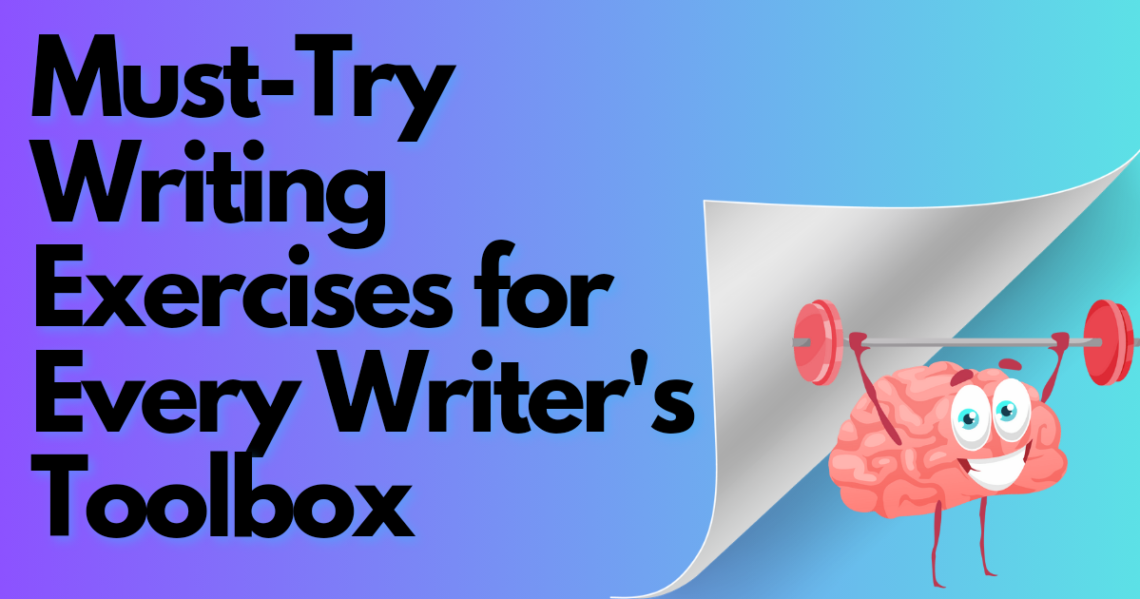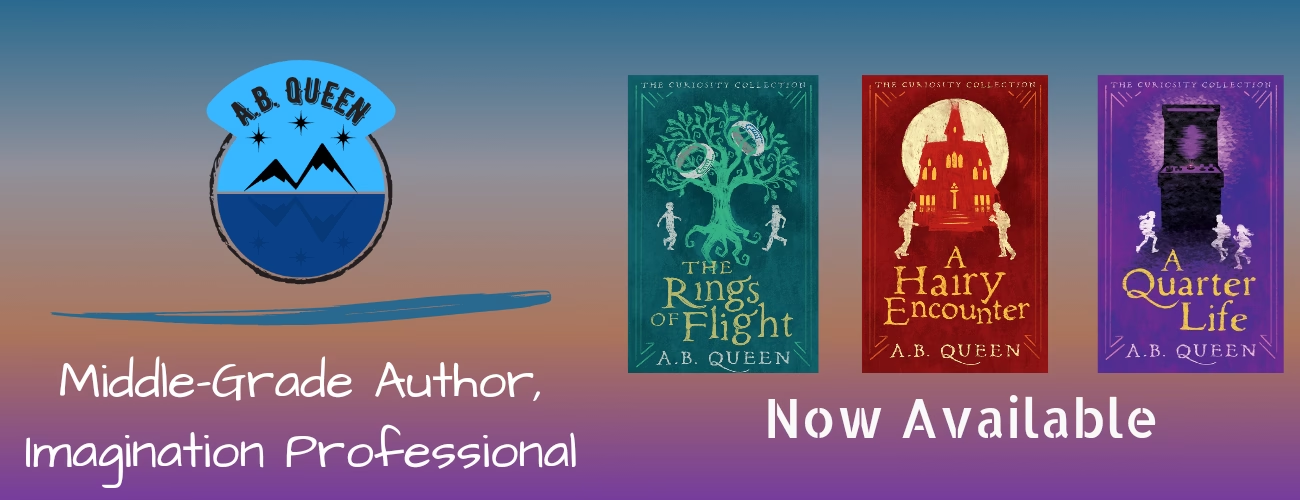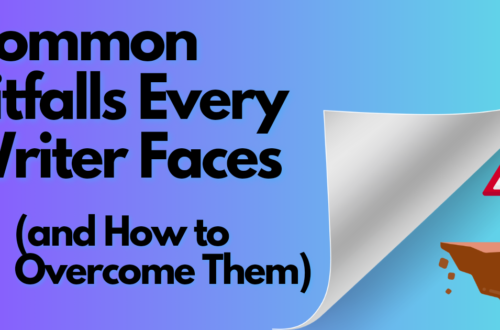
Must-Try Writing Exercises for Every Writer’s Toolbox
“Either write something worth reading or do something worth writing.”
Benjamin Franklin
As writers, we should always be looking to expand our skillset and our craft. To be honest, we should be doing this with any job we take on. I am a strong believer that it is important to continue to grow and learn as much as you can throughout your life. But by the looks of it, I don’t need to tell you that just by visiting this article, you are already taking the initiative to improve your writing skills in one way or another.
Which leads us to the purpose of this article. I want to help provide a range of writing exercises that you, the brilliant writer that you already are, can put into place when needing to expand your skills and creativity.
Why Writing Exercises are Important
Skill Improvement
While I have already touched a bit on my beliefs about advancing our skills and learning something new, I am, by far, not alone in this thought and practice. With any skill, you will only become better the more you practice.
I used to have a band teacher in middle school who constantly told us to “practice, practice, practice.” It drove me and my friends nuts every time we heard this. And we heard it at the end of every practice. While it annoyed me as a young human, I didn’t really understand it until my late teen years, when I spent every waking hour taking on another instrument, the guitar. I quickly saw how fast my skills grew by putting time and effort into them. I now try to apply that same mentality and dedication to writing. Hell, it’s actually one of the reasons I am writing this article. It gives me the chance to practice my skills and improve them.
Overcoming Writer’s Block
I talk about writer’s block quite often, in fact, I am currently writing an article on the challenges of writer’s block and how to get over it by never having it. In the meantime, I will talk briefly here about it and the importance of writing exercises when it comes to writer’s block.
Every writer will get a form of writer’s block at some point in their life. It may only last an hour or multiple years. One of the best ways to avoid writer’s block, or at least defeat it when you have it, is to use writing exercises. Exercise takes you out of your comfort zone of daily habits and into new territory. Any one of the exercises we will talk about below can help rid your mind of writer’s block.
Building Creativity
This is actually one of the main reasons I practice different writing exercises throughout the week. I am always on the hunt to build my creative skillset and be seen as a highly creative person. I am addicted to being creative, and writing exercises have helped me become that way.
Sitting down with a notebook and writing five new magical items a day, re-writing a story into a fan fiction series, or people watching and creating dialogue for them. All of these exercises have helped me be the creative person I am today. They can help free your mind from logical writing into a fun and creative way of writing.
The worst thing you can do is censor yourself as the pencil hits the paper. You must not edit until you get it all on paper. If you can put everything down, stream-of-consciousness, you’ll do yourself a service.
Stephen Sondheim
Warm-Up Exercises
Warm-up exercises I find useful for everyday practice. Kind of like stretching in the morning or making your coffee, they are a low-stake way to help prep the mind and get it moving for a successful and enjoyable writing session.
Freewriting
Freewriting. Simple, stress-free, and can be any length of time. The goal is to write for a dedicated amount of time without worrying about things such as grammar, editing, or the structure of the story. It is writing about a topic to get the words out there and then going back later to clean it all up.
This is actually how I spend most of my writing sessions. As the name implies, it is very freeing and rewarding at the same time.
Stream of Consciousness
This one is kind of a blast, as you never really know what is going to happen. Your mind is a fascinating and brilliant place, capable of an incredibly random stream of thoughts, why not record it? This practice involves either a notebook, a computer, or even a recording device to let it all out. You don’t need to stick to a subject, in fact, you shouldn’t. The main purpose is to word vomit whatever comes to your mind and keep going for a set period of time.
The great thing about this exercise is that it is incredibly therapeutic. No one ever needs to see what you wrote, and it allows your mind to get all those thoughts out of your head that distract you from writing your story.
Morning Pages
Morning pages are a common routine for many successful people. Kind of a cousin to Stream of Consciousness, it allows you to get what is in your head out and onto some pages. The difference with this one is that it usually involves a physical journal/longhand.
At some point in the beginning of the day—shortly after you wake up, but before you begin work—take the time to write three pages in your journal of whatever you are feeling, thinking, wishing, wanting, or whatever you would like. It uses the stream-of-consciousness method, but places it first thing in the day and by hand, forcing you to process everything a bit more than typing.
Creativity Boosters
Creativity boosters are for the daydreamers. This is the perfect way to push the creative section of your mind a bit more and let that freak flag fly high.
Writing Prompts
When you search Google for writing prompts, you can find hundreds of results to spark your imagination. Essentially, writing prompts give you a scenario and/or specifics on what to write. It takes some of the stress away from what to write.
Examples:
- A boy finds a magic pencil in an abandoned school. What next?
- Three horses become best friends on an old man’s farm. What is their day-to-day routine?
- The captain of a pirate ship loses the treasure map. What does he do?
These are but a few examples of the millions out there. They can also give you some guidelines to follow. Guidelines such as these must take place in the summer. Only written in the first person. Or, write a short story in a hundred words or less. I did this here and had a blast writing it.
Writing prompts can be a great way to start a story or even finish it. Do yourself a favor, complete a quick search, and try some out.
Object Writing
Object writing is an excellent way to work on your prose. We have all gotten stuck when trying to describe a scene or an object. Sometimes the words just don’t come to us. Well, when you practice the object-writing exercise, it can strengthen this area of your skillset.
The idea behind this one is to take any object, literally any object, and describe it in as much detail as possible, focusing on sensory detail. Describing the color, shape, space it takes up, time it uses, smell, look, feel, pretty much anything you can use to describe the object. I find it helps to be as goofy and quirky as possible with this exercise.
What-If Scenarios
If you are like me and a fan of Marvel, you will love this exercise. This is actually the question I always ask myself when brainstorming ideas, and it hasn’t failed me yet.
The reason I brought up Marvel is that they have an animated series that is actually based off of a comic run from the 1970s and 1980s. They tackle the big questions of items such as “What if The Hulk had the brain of Bruce Banner?” or “What if Spiderman joined The Fantastic Four?”. These were questions that allowed the writers to break free from the current story line and have some fun with different scenarios.
Honestly, this is actually what most fiction writers ask themselves. What if..(Fill in blank). It’s the reason we have so many amazingly fantastic worlds to escape to.
“When writing a novel a writer should create living people; people not characters. A character is a caricature.”
Ernest Hemingway – Death in the Afternoon
Character Development Exercises
The fear of boring and flat characters. We all dread the day we realize our characters could have been more dimensional. Using the exercises below could help prevent that day from ever happening.
Character Sketches
Any player of D&D has already done this, most likely multiple times. Honestly, it is one of my favorite parts of D&D. Creating a character and bringing it to life through backstory, personality, motivations, traits, or even destiny.
Take a character of yours and write as detailed a life as you can about them. Where they were born, their first childhood friend, favorite food on Sunday mornings, their grades in school, the creatures they are scared of the most, what type of driver they are, or thousands of other details. Essentially, the goal is to bring this character to life. Getting an understanding of what makes this character tick.
Bonus Points: Take an existing character from your favorite show and add on to what you already know about them. What led them to the person they are today (during the show).
Dialogue Practice
Dialogue can be a very difficult part of any writer’s work. Trying to capture naturally flowing dialogue when the conversation didn’t really happen is tricky. Use too much proper grammar, and it sounds stiff and restricted. Be too relaxed, and it can be difficult to follow and understand.
A way to help with this is to take a conversation you have recently had and try to write it as close to it as you remember. Capturing the small filler words, the pauses, and the adjectives that people use.
You can also listen to podcasts, as those are usually not scripted, study them, and write them down. This can give a good sense of realistic dialogue between real humans.
Character Interviews
Going off of the podcast idea, creating interviews with your characters is another way to explore them as a real humans. Picturing them on a talk show or a podcast where they are being interviewed about their thoughts, feelings, and ticks can give you some real insight into what you want the character to be and sound like.
While this may seem a bit odd, it’s really just another way for us, as writers, to push our brains into the creative space, freeing it for spectacular pieces of work.
If you do enough planning before you start to write, there’s no way you can have writer’s block. I do a complete chapter by chapter outline. At least I can write.
R.L. Stine
Plot and Structure Exercises
Plot and structure are, of course, critical to the success of any book. Without a good plot, there is no story. Plots can be tricky to navigate, and plot holes can appear out of nowhere. However, there are some good exercises that can help make the journey smooth and hole-free.
Plot Outlines
Outlines can be a bit overwhelming. I used to not be someone who outlined and just wrote the story, letting it grow in any direction it needed. However, I have discovered that outlining has increased my productivity and stimulated my creativity.
Outlining is perfect for those who love the idea of worldbuilding. It provides you with an outlet to not just write a story but also create a universe. You can create character sketches, build artifacts and objects, build civilizations, and tear them down all before you put a single word in your first chapter.
Essentially, outlines can be used as a sandbox, allowing you to explore the universe you are about to create. It also permits you to figure out major plot points and work out any kinks you may have before you write fifteen chapters and get stuck.
Scene Summaries
When you write a scene, you should ask yourself if the scene offers any value to the story and reader, or is it just fluff to add words to a page? If it’s just fluff, it can be difficult to cut later in the edits as the writer. And as the writer, you may have become attached to it.
To avoid these difficult decisions later in the edits, take some time before writing the scene and ask what the purpose is, and does it move the story forward? It doesn’t have to be big, and it can even be a detail needed for a story in a later book in the series, but as long as you know it, it moves it forward.
I find it helps to ask myself in the outline process what the purpose of the scene is. Getting into this habit and practicing this exercise has helped save me multiple rewrites and edits later in the book.
Storyboarding
A writing exercise for those that prefer visually appealing methods, storyboarding is the perfect exercise. Not to mention, it helps build a skillset through multiple forms of writing careers (film, comics, picture books).
Take a few minutes each day to create a storyboard of the scene or chapter you want to write. This can be done by doing some Google image searches and placing them in Google Docs. Or another way that I am a fan of is using Pinterest to build a storyboard. A super easy and intuitive way to visually understand your scene and story.
Style and Voice Exercises
Finding your style may take some time, and when you write, you may not see your style or voice. There are plenty of exercises out there to help you find your voice.
Mimicry
Mimicry is the perfect exercise to help you better understand your favorite authors. Taking an idea, writing a short piece, and trying to write in the style of your favorite author can help you identify how they may structure a sentence compared to how you structure a sentence. It may help you understand the flow of a story, the details of a character, or even the preferred grammatical techniques.
A way to go above and beyond this is to work on writing a story in the style of a favorite author, then take the same story and use your usual method of writing to write it in your style. Separating the two gives you a side-by-side comparison while also stretching the brain.
Tone Variations
The tone of your story can be a difficult thing to convey, especially if you aren’t sure what tone you are going for. Take a sentence you have written and try to write it in as many different tones as possible. Turn it suspenseful, humorous, overly dramatic, or as monotone as you possibly can.
You will find that this can completely change the style of your story and the voice of your character. But it also allows you to use different adjectives, descriptors, and maybe even your personal feelings toward the story.
First-Person vs. Third-Person
This one I have been playing around with a bit more on one of my own stories. I was having trouble deciding how I wanted to portray the story. So, I took thirty minutes and wrote a few hundred words from one point of view and then from another.
This gave me perspective on my story, my characters, and what the readers may enjoy. I also found that it freed my mind a good amount when it came to better describing scenarios and not feeling trapped in a single style and voice of writing.
Setting and Description Exercises
A few of the exercises we have talked about have already covered some ways they may lead to better descriptions. However, if you are looking for something more specific in that area, the next few may be the right writing exercises for you.
Sensory Details
An amazing way to help build up your writing skills is to have a strong sense of description, and a great way to accomplish this is to take your work and use all senses of the human body to better describe the scene. When a character experiences something, have them experience it through each of their senses.
Show, Don’t Tell
A common piece of advice in the writing world, and most writers will receive it sooner or later. While this one can be a bit more difficult to navigate because everyone has their own personal preference, it can still be a good writing exercise to practice.
Sometimes all of us may get a little carried away with getting to the point. I mean, we live in a world where everything is so demanding and instant. But using your writing to slow things down and savor the scene by showing it can breathe new life into your work.
Location Swap
This writing exercise is another fun and unique one to try when you are bored. Take a scene that you have already written and put it in a different location. In fantasy, authors can find themselves imagining the same place over and over, which leaks into their writing and can be boring for the reader. However, if we practice changing some scenes, we can stretch the imagination and have some fun with the story.
It doesn’t need to be permanent, but maybe that book set in the Midwest may find new life when placed in Hawaii.
“Don’t classify me, read me. I’m a writer, not a genre.”
Carlos Fuentes
Genre-Specific Exercises
Genre Mashup
Okay, this one is a super fun and exciting way to practice a writing exercise. I would go as far as to say that it is the reason we have some new sub-genres in the world of fiction.
To push your boundaries as a writer, take a favorite story of yours and combine it with a completely different genre. Try to blend them seamlessly, giving the reader a strong sense of both genres but being unsure of where to place them.
Example:
- Take an epic fantasy story and add in a murder mystery genre.
- Or maybe a sci-fi story that is a self-help book.
Genre Conventions
This writing exercise may not seem as exciting as some of the others, but it can actually be more difficult than expected. If we break down a genre, you will find that it usually falls under a specific range of conventions and rules. Now, take all of those conventions and strictly stick to them. Do NOT deviate from them. Sometimes we try to deviate to enhance the story or make it fresh. However, by forcing ourselves to stick to the conventions, we are forcing our brains to still think of something new and fresh, and it is going to work harder to find it. This is what we want.
Subverting Tropes
Novel tropes exist for a reason, they’re what people have demanded and wanted. But if we take the last writing exercise and flip it upside down, we can take a look at genre tropes and go against them to move the story forward. This once again forces the brain to think differently and pushes creativity to the forefront of your process.
Do this enough, and you will rewire your brain to see tropes and think about our other exercise, “What if?”.
“The road to hell is paved with adverbs.”
Stephen King
Editing and Revision Exercises
Here’s the thing about editing and revisions, I often find you either hate it or you love it. Whichever side you lean to, we can all learn to improve the process even more to make it a smoother writing process and a more efficient writing process.
Cutting the Fluff
This editing exercise can be a difficult one to implement. Taking your work and removing unnecessary words and content feels like removing part of yourself. After all of the hard work you put into it, you want to keep it all. However, creating a copy of your work (a piece of advice I always recommend) and removing more than you feel comfortable with can shine a light on the core of your story. It can provide insight into what works and what doesn’t.
To do this, you can start by removing some common adverbs that writers will overuse. Do a search in your document for anything that ends in “ly”. Then go through and remove as much as you can. This, of course, doesn’t mean you can’t keep it, after all, it’s your writing, but it does help provide some insight.
Reverse Outlining
We spoke above about outlining your story to feel more comfortable in your world and using it as a sandbox. Instead of starting before you write the story, try outlining a story you have finished. This will help define the coherence and structure of your story and can even help identify plot holes.
Peer Review
I have mentioned this article here, peer review is a fantastic way to improve your writing if you are willing to share your work. There is a hesitation about sharing our work, as it can leave us feeling vulnerable. However, by finding the right partner, you can provide them with a copy of your work and ask for a review. This is essentially what beta reviewers are, but it can be a bit less intimidating with someone you trust and have a good working relationship with.
“Alone we can do so little; together we can do so much”
Helen Keller
Collaborative Writing Exercises
A strong writing group can improve most writers’s skills and techniques. With a group comes some beautiful writing exercises for the whole group to try.
Round-Robin Stories
One that I have yet to try but is on my bucket list. Round-Robin Stories is the madlib of a group writing exercise. It works by having the group decide on a single aspect of a story, such as a location, character, or item. Then, each member of the group writes a section of the story. By the end, you have a knitted hodgepodge of a story that is sure to be fun and exciting.
Writing Prompts Exchange
This one has the ability to add in a good amount of the writing exercises we have talked about, specifically peer review and writing prompts. Choose a partner and provide them with a writing prompt, with them providing one for you as well. At a later designated time, give them back, review, and discuss.
For an added bonus, select a random prompt in a random genre with a random partner from a writing group. Can keep things going for a long, long time.
Group Story Building
Building off of the Round-Robin Stories and adding in some teamwork, having a group write a story together is a great writing exercise for all involved. Create a story from scratch, with each person in the group adding a sentence or a paragraph until you have a complete story. This works great for short stories (depending on the group size).
“Probably the most important thing I’ve learned is that if I don’t make the time to do the writing, the writing won’t get done.”
Judy Reeves
Timed Writing Challenges
The great thing about writing exercises is that they can be done at just about any time, especially when you put a time component into your writing exercise. They don’t need to take up a lot of time, and in fact, they can be short and sweet.
Sprints
Writing sprints can use freewriting, stream-of-consciousness, or even just your usual writing routine, but with a clock added. Set a time for any duration of time, from 1 minute to 60 minutes, and just write. No distractions, no worries, just write.
The amount you could achieve at the end of these sprints is pretty damn incredible. Do this for ten minutes a day, and you could have the novel written in no time.
Flash Fiction
We have already briefly touched on this style of writing exercise, but we didn’t talk about the time frame. Essentially, you take a set word amount—something short, such as 1,000 words—then you take a dedicated amount of time and write a story.
The idea is to come out at the end of the dedicated time with a short story. The time component adds a bit of extra stress to your session, pushing your creativity to a new limit.
Deadline Pressure
I have seen this one online a lot, and, to be honest, I have mixed feelings about it. Setting yourself a deadline to stimulate real-world conditions can trigger the “get it done” productivity part of your brain.
However, I do recommend being careful with this one, as it can set some nasty habits that you didn’t mean to set.
“Knowing yourself is the beginning of all wisdom.”
Aristotle, Metaphysics (350 BC)
Reflective Exercises
We are our greatest and toughest critics. We tend to be harsh and cruel to ourselves when we don’t need to. That is why exercising reflective techniques is crucial to a happy and healthy writing career.
Writing Journals
I am a strong believer in writing journals and believe everyone should keep one, whether you are a writer or not. Spending a few minutes each day reflecting on your writing process and progress is a healthy way to advance your skills. Being honest with areas that you believe you are doing well in, as well as areas that you think you may need more practice.
Self-Review
Self-review is much like a self-reflective writing journal, but instead, by taking a look at your writing. It’s not the easiest thing to do, sometimes it can be a bit cringy to go back and read some of your previous work and compare it to your newer work. However, this can help put everything in perspective and show just how far you’ve come as a writer.
Goal Setting
I have talked about goal-setting a good amount in previous articles, and that’s because I believe it is important to do. Setting goals may not be seen as the fanciest writing exercise to improve your craft, but it is very beneficial. It’s all about understanding your process and capabilities. By setting goals and regularly reviewing and updating them, you can have reasonable expectations of your writing process and commitments.
Conclusion
We have talked about a boatload of writing exercises in this article. From group settings to character development, there is bound to be something for just about every writer. When it comes to any writing exercise, it isn’t about doing them all in a day and then forgetting about them, it’s about consistent practice in manageable chunks. Just like working out. Don’t overdue it, and know your limits. But by sticking to a regularly planned schedule of exercises, your craft of writing is sure to advance and improve.
If you do happen to try any of these writing exercises or happen to have some that you practice and I didn’t mention, drop a comment and let us know your favorites and/or how the ones in this article have helped you.
Until next time,
Please note that links in this site contains product affiliate links. At no extra cost to you, I may receive a commission if you make a purchase after clicking on one of these links.





